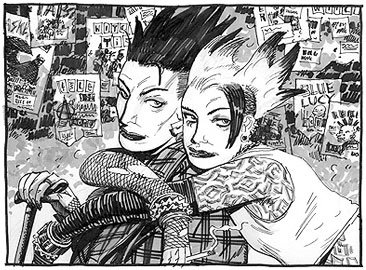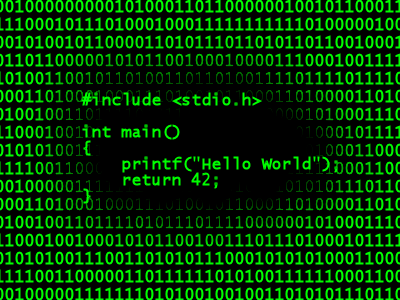High-Tech Low-Life Roleplaying

That little tag on the front is not a joke, this book totally got Steve Jackson V&. The FBI has no sense of humor that they are aware of even now, and back in 1990 they seriously didn't know the difference between a cyberterrorist plot and a role playing game supplement.
”The Hacker Crackdown” wrote: And then there was GURPS Cyberpunk.
"Cyberpunk" was a term given to certain science fiction writers who had entered the genre in the 1980s. "Cyberpunk," as the label implies, had two general distinguishing features. First, its writers had a compelling interest in information technology, an interest closely akin to science fiction's earlier fascination with space travel. And second, these writers were "punks," with all the distinguishing features that that implies: Bohemian artiness, youth run wild, an air of deliberate rebellion, funny clothes and hair, odd politics, a fondness for abrasive rock and roll; in a word, trouble.
The "cyberpunk" SF writers were a small group of mostly college- educated white middle-class litterateurs, scattered through the US and Canada. Only one, Rudy Rucker, a professor of computer science in Silicon Valley, could rank with even the humblest computer hacker. But, except for Professor Rucker, the "cyberpunk" authors were not programmers or hardware experts; they considered themselves artists (as, indeed, did Professor Rucker). However, these writers all owned computers, and took an intense and public interest in the social ramifications of the information industry.
The cyberpunks had a strong following among the global generation that had grown up in a world of computers, multinational networks, and cable television. Their outlook was considered somewhat morbid, cynical, and dark, but then again, so was the outlook of their generational peers. As that generation matured and increased in strength and influence, so did the cyberpunks. As science-fiction writers went, they were doing fairly well for themselves. By the late 1980s, their work had attracted attention from gaming companies, including Steve Jackson Games, which was planning a cyberpunk simulation for the flourishing GURPS gamingsystem.
The time seemed ripe for such a product, which had already been proven in the marketplace. The first gamescompany out of the gate, with a product boldly called "Cyberpunk" in defiance of possible infringement- ofcopyright suits, had been an upstart group called R. Talsorian. Talsorian's Cyberpunk was a fairly decent game, but the mechanics of the simulation system left a lot to be desired. Commercially, however, the game did very well.
The next cyberpunk game had been the even more successful Shadowrun by FASA Corporation. The mechanics of this game were fine, but the scenario was rendered moronic by sappy fantasy elements like elves, trolls, wizards, and dragons -- all highly ideologically- incorrect, according to the hard-edged, high-tech standards of cyberpunk science fiction.
From Bruce Sterling’s The Hacker Crackdown, which is legally available free because Sterling kept the electronic rights and wanted people to actually read it.”The Hacker Crackdown” wrote: The exact details of the next events are unclear. The agents would not let anyone else into the building. Their search warrant, when produced, was unsigned. Apparently they breakfasted from the local "Whataburger," as the litter from hamburgers was later found inside. They also extensively sampled a bag of jellybeans kept by an SJG employee. Someone tore a "Dukakis for President" sticker from the wall.
SJG employees, diligently showing up for the day's work, were met at the door and briefly questioned by U.S. Secret Service agents. The employees watched in astonishment as agents wielding crowbars and screwdrivers emerged with captive machines. They attacked outdoor storage units with boltcutters. The agents wore blue nylon windbreakers with "SECRET SERVICE" stencilled across the back, with running-shoes and jeans.
Jackson's company lost three computers, several hard-disks, hundred of floppy disks, two monitors, three modems, a laser printer, various powercords, cables, and adapters (and, oddly, a small bag of screws, bolts and nuts). The seizure of Illuminati BBS deprived SJG of all the programs, text files, and private e-mail on the board. The loss of two other SJG computers was a severe blow as well, since it caused the loss of electronically stored contracts, financial projections, address directories, mailing lists, personnel files, business correspondence, and, not least, the drafts of forthcoming games and gaming books.
No one at Steve Jackson Games was arrested. No one was accused of any crime. No charges were filed. Everything appropriated was officially kept as "evidence" of crimes never specified.

It was 1990, and the United States law enforcement initiated a massive effort to take down hackers. The technology involved seems incredibly ancient to modern days, the laws antiquated and draconian, the police and Feds having a Hollywood sense of what hacking was and could do, acting like big cowboys. So yes, they were stupid and ignorant and as part of a series of raids on hackers and suspected hackers the Secret Service managed to bust in to a roleplaying game company and steal their stuff under the belief that it was real.
”The Hacker Crackdown” wrote: The day after the raid, Steve Jackson visited the local Secret Service headquarters with a lawyer in tow. There he confronted Tim Foley (still in Austin at that time) and demanded his book back. But there was trouble. GURPS Cyberpunk, alleged a Secret Service agent to astonished businessman Steve Jackson, was "a manual for computer crime."
"It's science fiction," Jackson said.
"No, this is real." This statement was repeated several times, by several agents. Jackson's ominously accurate game had passed from pure, obscure, smallscale fantasy into the impure, highly publicized, largescale fantasy of the Hacker Crackdown. No mention was made of the real reason for the search. According to their search warrant, the raiders had expected to find the E911 Document stored on Jackson's bulletin board system. But that warrant was sealed; a procedure that most law enforcement agencies will use only when lives are demonstrably in danger. The raiders' true motives were not discovered until the Jackson searchwarrant was unsealed by his lawyers, many months later. The Secret Service, and the Chicago Computer Fraud and Abuse Task Force, said absolutely nothing to Steve Jackson about any threat to the police 911 System. They said nothing about the Atlanta Three, nothing about Phrack or Knight Lightning, nothing about Terminus.
Jackson was left to believe that his computers had been seized because he intended to publish a science fiction book that law enforcement considered too dangerous to see print.
This misconception was repeated again and again, for months, to an ever-widening public audience. It was not the truth of the case; but as months passed, and this misconception was publicly printed again and again, it became one of the few publicly known "facts" about the mysterious Hacker Crackdown. The Secret Service had seized a computer to stop the publication of a cyberpunk science fiction book.
GURPS as a whole is thoroughly a product of the late 80s. If game design of the 70s was best described as “trying to get house rules together to make D&D work at all”, the 80s were all about trying to make game systems “perfect” so that they could be used in any context. That might sound like a really stupid idea – and it was – but back when I was in grade school this idea was cutting edge. And no system, not even HERO, took the idea of universality as far as GURPS did. There are books about how to make GURPS do fantasy, how to make it do science fiction, how to make it do pulp, how to make it do time traveling circus people, it does it all. Except for the fact that this is still a really dumb idea, in that a resolution system that handles a 9mm pistol in a gritty police procedural can't handle a 9mm pistol in a two fisted pulp detective story, because despite the fact that those are literally the same item they are structurally different and the expectations of what they should do are totally not reconcilable. The promise of GURPS was truly something that could never really be achieved, and it was basically a bad idea for the same reason that d20 Modern was a bad idea.
But in the 80s, that wasn't known or understood. It seems obvious in retrospect, but at the time it seemed like something GURPS-like was the ultimate goal of game design. And everything good and bad about GURPS is why we thought that was a thing we could do at the time, and why we don't think so any more.
The ideal of a universal system is still among gamers, because at the core of the hobby remains a simulationist mindset—we do want to adventure in the worlds of Conan, Elric of Melnibone, the Lord of the Rings, Neuromancer, Star Trek, Star Wars, Babylon 5, the Dresden Files, Supernatural, Buffy the Vampire Slayers, &c. GURPS is only one of a handful of systems that stepped in to meet this need – others include Masterbook and Basic Roleplaying, which provided a single system on which multiple settings could be hung. In a large part, this paved the way for contemporary systems like d20 and World of Darkness. Even GURPS finally caved in a little, providing a default setting based on the Alternate Earth/Time Travel books for GURPS 4e.
Steve Jackson (that's US Steve Jackson for you Fighting Fantasy fans) put a lot more effort into this sort of thing than, for example, Kevin Siembieda. So this book has playtesters and consultants. It wouldn't really surprise me if getting hacking consultation from “The Legion of Doom” was what got the FBI interested in the first place. But the point here is that Steve Jackson cares about his product and he's willing to spend money and time to improve it within his paradigm – and it shows in the credits.
And of course... there is also that.Credits wrote:Unsolicited Comments: United States Secret Service
GURPS may be old-school, but they were a quality production – they brought in a million dollars of revenue in 1990. While GURPS may not have been the most innovative in terms of game book design, they were as top of the line as anything put out by TSR or White Wolf – and usually with a much more readable layout and more complete table of contents.”GURPS Cyberpunk” wrote: The Steve Jackson Games staff offers our somewhat bemused thanks to the United States Secret Service for their diligent "reality checking" of GURPS Cyberpunk. It happened like this…
On March 1 the SJ Games offices, and the home of the GURPS Cyberpunk writer, were raided by the U.S. Secret Service as part of a nationwide investigation of data piracy. A large amount of equipment was seized, including four computers, two laser printers, some loose hard disks and a great deal of assorted hardware. One of the computers was the one running the Illuminati BBS.
The only computers taken were those with GURPS Cyberpunk files; other systems were left in place. In their diligent search for evidence, the agents also cut off locks, forced open footlockers, tore up dozens of boxes in the warehouse, and bent two of our letter openers attempting to pick the lock on a file cabinet.
The next day, accompanied by an attorney, I personally visited the Austin offices of the Secret Service. We had been promised that we could make copies of our files. As it turned out, we were only allowed to copy a few files, and only from one system. Still missing were all the current text files and hard copy for this book, as well as the files for the Illuminnati BBS with their extensive playtest comments.
In the course of that visit, it became clear that the investigating agents considered GURPS Cyberpunk to be "a handbook lor computer crime." They seemed to make no distinction between a discussion of futuristic credit fraud, using equipment that doesn't exist, and modern real-life credit card abuse. A repeated comment by the agents was "This is real."
Now I'll freely admit that this book is the most realistic cyberpunk game yet released. It has a lot of background information to put the genre in context. But it won't make you into a console cowboy in one easy lesson any more than GURPS Fantasy will teach you swordplay. Sadly the distinction appeared lost on the investigators.
Over the next few weeks, the Secret Service repeatedly assured our attorney that complete copies of our files would be returned "tomorrow." But these promises weren't kept; this book was reconstructed from old backups, playtest copies, notes and memories.
On March 26, almost four weeks alter the raid, some (but not all) of the files were returned. It was June 21 nearly four months later, when we got most (but not all) of our hardware back. The Secret Service still has one of our hard disks, all Loyd's personal equipment and files, the printouts of GURPS Cyberpunk, and several other things.
Introduction
The book opens with a bit on how you personally can get tech support with GURPS. This being 1990, your choices are to send written letters to their offices in Texas, or by dialing up to their 14.4 baud modem in the 512 area code. High tech!
I don’t think GURPS invented the sidebar, but given the modular nature of GURPS products (GURPS Cyberpunk + GURPS Fantasy + GURPS Vikings? Sure, why the fuck not? The priests of Wotan need you berserkers, before the giant hackers of Jotunheim break in to the digital heaven of Valhalla!) it makes sense that the first one in the book is basically a plug for the rest of GURPS products. More often though, sidebars in GURPS books tend to actually be useful as opposed to just fluff-pieces…depending on the writer.
The second introduction (there are four, crammed into two pages with side bars, underbars, and maple bars) is the “What is Cyberpunk?” section. Fascinatingly, it doesn't bother with a “What is Roleplaying?” section. The assumption here is I guess that this is not your first GURPS product and they don't have to tell you what Roleplaying is. Personally, I don't need to be told what roleplaying is, but sometimes it's nice to know what roleplaying means to the authors. To see if we are remotely on the same page. Ah well.
This is the days before wikipedia, and so it is that the author blithely informs us that William Gibson was the first person to use the word “Cyberpunk” in his book Neuromancer in 1984. This is of course, totally wrong, as today anyone can spend 30 seconds on Google and find that Bruce Bethke's short story “Cyberpunk” was published in 1983. But in the days of card catalogs and library research in actual libraries, this kind of confusion was commonplace.
More anachronisms are in store for you, however. The dark cyberpunk future apparently predicts that life will be cheap because there might be as many as twenty million people in sprawls like New York (population 22 million) or Tokyo (population 32 million). I know it's been twenty three years, but that particular bleak vision of the future is now a long time passed.
It really is hard to remember the time back when Japan ruled the future.

Introduction 3 is a shortened version of their ordeal in getting this book published. What with the fact that apparently some treasury agents thought this book was an actual how-to guide to commit modern day credit card fraud. This is only a tiny glimpse down that particular rabbit hole, and it doesn't ever get less crazy. The more information you get about this, the more retarded and venal the US government looks.
Some of the other books GURPS suggests include GURPS Ultra-Tech, GURPS Supers, GURPS Autoduel (wow, taste the 80s), and GURPS Humanx, which is devoted to a setting of books by Alan Dean Foster before he started just whoring himself out for money by writing the novelizations to the Transformers movies.
The final introduction in the introduction is a bit pimping other books in the GURPS series, noting that you can probably use stuff written up in other GURPS books in your GURPS CYBERPUNK campaign. What with them having been written for the same system and that being the entire point of GURPS. Also, the author notes that he is such a decadent futurist that he can be reached via e-mail. Holy fuck!
Loyd “Mentor” Blankenship is a large part of the reason the book was confiscated by the SS, but don’t hold that against him. He would later go on to write The Conscience of a Hacker, GURPS China, and other stuff like that.
Probably the weirdest thing about cyberpunk is that by 1990 it wasn’t exactly dead, but it had run its course as avant garde literature but hadn’t started to really filter into movies yet. William Gibson finished up the Sprawl Trilogy in ’88, and the nail in the coffin that was Neal Stephenson’s Snow Crash would be out in ’92. Lawnmower Man and Sneakers wouldn’t be out until ’92, Johnny Mnemonic and Hackers wouldn’t be out ‘til ’95…this was a game for people that had grown up on Blade Runner (1982), War Games (1983), and The Terminator (1984). “High tech and low life” sums it up nicely.







